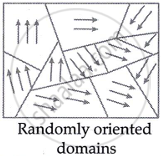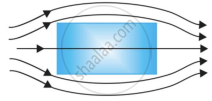Advertisements
Advertisements
प्रश्न
Explain ferromagnetism on the basis of the domain theory.
Explain ferromagnetism with the help of suitable diagrams, using the concept of magnetic domain.
उत्तर १
Due mostly to the electrons' spin magnetic moments, ferromagnetic material atoms have a persistent non-zero magnetic dipole moment. Little areas known as domains make up a ferromagnetic substance, according to the domain hypothesis. An incredibly small area with a high concentration of atoms—roughly 1015 atoms, or the same number as ordinary iron—is called a domain. Even in the absence of an external magnetic field, the atomic magnetic moments of nearest-neighbour atoms within each domain interact strongly through exchange interaction, a phenomenon described by quantum mechanics. As a result, the atoms align themselves parallel to one another. That is, a domain becomes spontaneously magnetised to saturation. In an unsealed substance, on the other hand, the net magnetisation is zero due to the distinct domains' magnetisation orientations being so aligned.

Domains in a single crystal of iron The arrows indicate the direction and magnitude of the magnetization of each domain.
The specimen becomes more magnetised as a result of applying an external magnetic field. One of two methods is used to do this: either a favourably oriented domain expands at the expense of a less favourably oriented domain, or the magnetisation direction of an entire domain shifts to align with the external magnetic field. Favourably oriented domains increase in size by domain border displacement when a weak magnetic field is applied, as shown in Fig. (b). Figs. (c) and (d) show how domain rotation causes the domains to shift their magnetisation under strong fields. When domains line perfectly, as they do in Fig. (d), they combine to form a single, huge domain.
It might be energetically advantageous for a domain's direction of magnetisation to continue after the external field is eliminated. A persistent magnetic dipole moment is thus present in the specimen. The existence of permanent magnets is based on a phenomenon known as magnetic remanence.
उत्तर २
Ferromagnetism based on domain theory:
- Individual atoms in ferromagnetic materials are linked to significant magnetic moments.
- The magnetic moments of atoms close to each other interact and naturally line up in the same way over large areas known as domains.
- Each domain typically measures approximately 1 mm and comprises around 1011 atoms. So, each domain possesses a significant magnetic moment.
- Without an external magnetic field, these domains are arbitrarily oriented, resulting in a net magnetic moment of zero.

- When subjected to a magnetic field, all of the domains align with one another along the direction of the field being applied.
- Magnets aggressively attract ferromagnetic materials.
- The alignment of domains may occur in either of the two ways.
- By displacing the boundaries of domains.
- By rotation of domains.
APPEARS IN
संबंधित प्रश्न
Distinguish between ‘paramagnetic’ and ‘ferromagnetic’ substances.
Which of the following substances is ductile?
The susceptibility of magnesium at 200 K is 1.8 x 10-5. At what temperature will the susceptibility decrease by 6 x 10-6?
Out of the two magnetic materials, 'A' has relative permeability slightly greater than unity while 'B' has less than unity. Identify the nature of the materials 'A' and 'B'. Will their susceptibilities be positive or negative?
Distinguish between diamagnetic and paramagnetic substances
Which of the following substances are diamagnetic?
Bi, Al, Na, Cu, Ca and Ni
Which of the following substances are para-magnetic?
Bi, Al, Cu, Ca, Pb, Ni
The relative magnetic permeability of a magnetic material is 800. Identify the nature of magnetic material and state its two properties.
Answer the following question.
Write three points of differences between para-, dia- and ferromagnetic materials, giving one example for each.
Which of the following statements is correct for diamagnetic materials?
Choose the correct option:
A rectangular magnet suspended freely has a period of oscillation equal to T. Now it is broken into two equal halves (each having half of the original length) and one piece is made to oscillate freely. Its period of oscillation is T′, the ratio of T′/T is ______.
A paramagnetic gas has 2.0 × 1026 atoms/m with atomic magnetic dipole moment of 1.5 × 10−23 A m2 each. The gas is at 27°C.
- Find the maximum magnetization intensity of this sample.
- If the gas in this problem is kept in a uniform magnetic field of 3 T, is it possible to achieve saturation magnetization? Why?
The susceptibility of a paramagnetic material is χ at 27° C. At what temperature its susceptibility be χ/3?
A rod of magnetic material of cross-section 0.25 cm2 is placed in a magnetizing field of intensity 4000 A/m-1. The magnetic flux passing through the rod is 25 × 10-6 Wb. Find out
(a) relative permeability
(b) magnetic susceptibility and
(c) magnetisation of the rod.
Magnetic material can be easily magnetized if magnetic susceptibility is ______.
There are three needles 'N1', 'N2' and 'N3' made of a ferromagnetic, a paramagnetic and a diamagnetic substance respectively. When a magnet is brought close to them, then it will ____________.
The materials having negative magnetic susceptibility are ____________.
The magnetic property of magnetic substance is associated with ____________.
The product of magnetic susceptibility (`chi`) and absolute temperature (T) is constant for a ____________.
A small quantity of paramagnetic liquid is taken in a watch - glass and kept on two dissimilar magnetic poles. The liquid ____________.
A domain in a ferromagnetic substance is in the form of a cube of side length 1 µm. If it contains 6 x 1010 atoms and each atomic dipole has a dipole moment of 7 x 10-24 Am2, then magnetization of the domain is ____________.
Which graph shows the variation of magnetic susceptibility (`chi`) with magnetizing field (H) for a paramagnetic substance?
Why does a paramagnetic sample display greater magnetisation (for the same magnetising field) when cooled?
Why is diamagnetism, in contrast, almost independent of temperature?
If a toroid uses bismuth for its core, will the field in the core be (slightly) greater or (slightly) less than when the core is empty?
Is the permeability of a ferromagnetic material independent of the magnetic field? If not, is it more for lower or higher fields?
Magnetic field lines are always nearly normal to the surface of a ferromagnet at every point. (This fact is analogous to the static electric field lines being normal to the surface of a conductor at every point.) Why?
A certain region of space is to be shielded from magnetic fields. Suggest a method.
A Rowland ring of mean radius 15 cm has 3500 turns of wire wound on a ferromagnetic core of relative permeability 800. What is the magnetic field B in the core for a magnetising current of 1.2 A?
Nickel shows ferromagnetic property at room temperature. If the temperature is increased beyond curie temperature, then it will show ______.
The given figure represents a material which is ______.

The coercivity of a small magnet where the ferromagnet gets demagnetized is 3 × 103 Am–1. The current required to be passed in a solenoid of length 10 cm and number of turns 100, so that the magnet gets demagnetized when inside the solenoid, is ______.
The magnetic susceptibility is negative for ______.
The magnetic susceptibility for diamagnetic materials is ______.
Earth's magnetic field analyses has a horizontal component except at:-
A hydrogen atom is paramagnetic. A hydrogen molecule is
Most of the substance show which of the magnetic property:-
According to the Atomic theory, on heating a magnet, the thermal energy of the elementary magnet ______
A paramagnetic sample shows a net magnetisation of 8 Am–1 when placed in an external magnetic field of 0.6 T at a temperature of 4 K. When the same sample is placed in an external magnetic field of 0.2 T at a temperature of 16 K, the magnetisation will be ______.
S is the surface of a lump of magnetic material.
- Lines of B are necessarily continuous across S.
- Some lines of B must be discontinuous across S.
- Lines of H are necessarily continuous across S.
- Lines of H cannot all be continuous across S.
A permanent magnet in the shape of a thin cylinder of length 10 cm has M = 106 A/m. Calculate the magnetisation current IM.
A uniform magnetic field gets modified as shown in figure when two specimens A and B are placed in it.
 |
 |
| (a) | (b) |
- Identify the specimen A and B.
- How is the magnetic susceptibility of specimen A different from that of specimen B?
- Assertion (A): Diamagnetic substances exhibit magnetism.
- Reason (R): Diamagnetic materials do not have a permanent magnetic dipole moment.
Which of the following has a permeability less than that of free space?
Which of the following cannot modify an external magnetic field as shown in the figure?

The relative magnetic permeability of a substance X is slightly less than unity and that of substance Y is slightly more than unity, then ______.
What is magnetic hysterisis?
Explain the Domain theory in brief.
Explain the meaning of the following statement:
Curie temperature for soft iron is 770°C.
Magnetic susceptibility of a diamagnetic substance ______.
